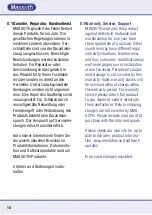
12
ten das man nicht mit abgesenktem
Haken fährt.
•
Das Entkuppeln sollte immer ohne
Last erfolgen. Rangieren Sie die
Lok und Wagen so, das sich die
Kupplung frei bewegen kann.
•
Wir empfehlen den Betrieb des
Entkupplers mit beidseitigem Haken
besonders bei langen oder schweren
Zügen (Betriebssicherheit).
•
Für optimale Betriebsergebnis muss
der Entkuppler auf gleicher Höhe
montiert sein, wie die verwendeten
Wagons.
•
Im Winterbetrieb ist das Eindringen
von Schnee und Eis zu verhindern.
•
Der Entkuppler ist begrenzt auf
maximal 5 Kuppelvorgänge je 30
Sekunden.
•
Sollte sich der Entkupplungshaken
durch eine Stromunterbrechung
oder mechanische Blockade nicht in
der Ausgangsposition befinden, so
wird dieser 2-4 Kalibrierbewegungen
brauchen um sich wieder in die
Normalstellung zurückzubewegen.
•
Sorgen Sie für eine sichere und sta-
bile Stromversorgung des Entkupp-
lers. Bei starken Schwankungen der
Versorgungsspannung kann es zu
Fehlauslösungen kommen. Eventuell
muss die Spannung des Dekoders
zusätzlich gepuffert werden.
on the Uncoupler. Always position
the train in a way that the Uncoupler
can operate freely.
•
We suggest you use the Uncoupler
with double-sided coupling in order
to pull long or heavy trains! (opera-
tional safety)
•
For best operating results the
Uncoupler needs to be mounted at
the same height as the coupler on
the trailing train.
•
The Uncoupler must be protected
from snow and ice when operated
in winter.
•
The Uncoupler is limited to a maxi-
mum of 5 uncoupling procedures
per 30 seconds.
•
If the hook does not return to its
original position as may occur fol-
lowing a power loss or mechanical
blockage the Uncoupler will take 2 to
4 calibrating moves to find its way
back to the original position.
•
Provide a safe and reliable power
supply to the Uncoupler. Fluctua-
tions in the supply voltage can cause
faulty operations. Additional buffe-
ring of the decoder‘s power supply
may remedy the problem.






































